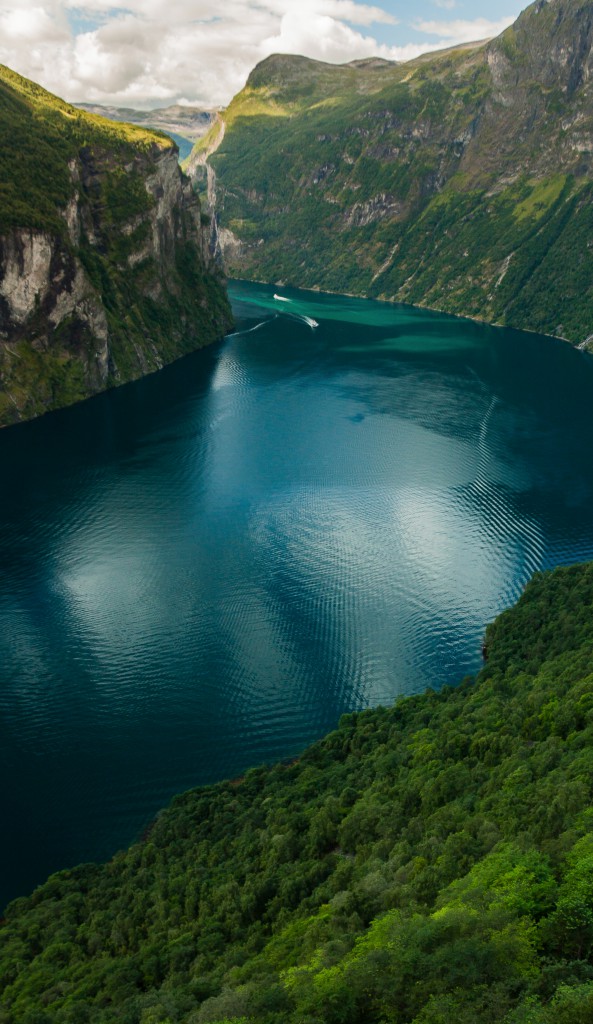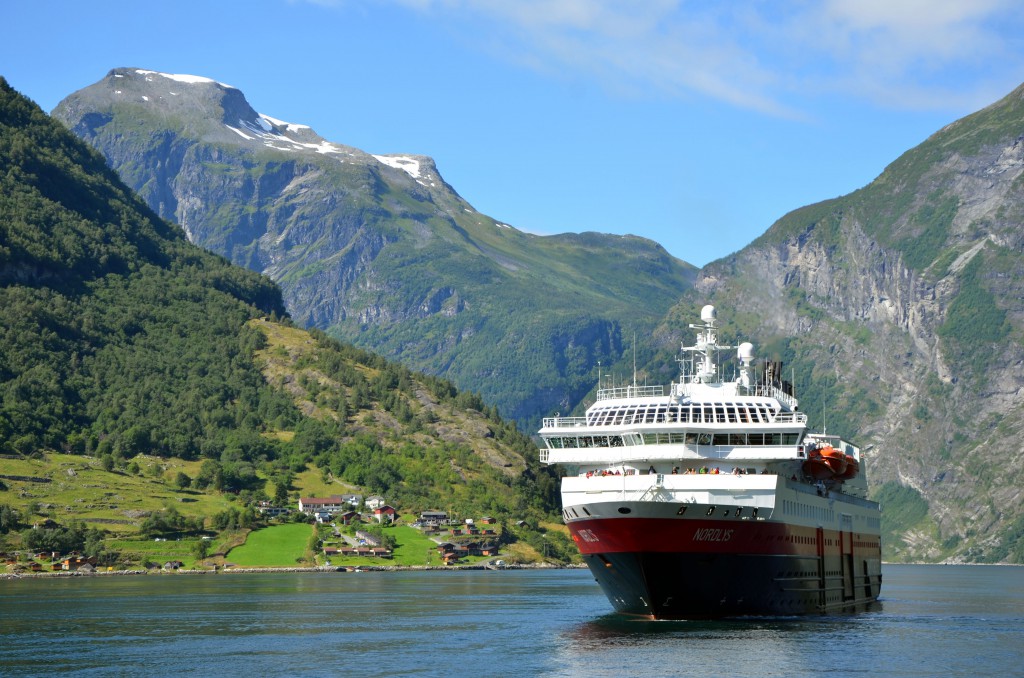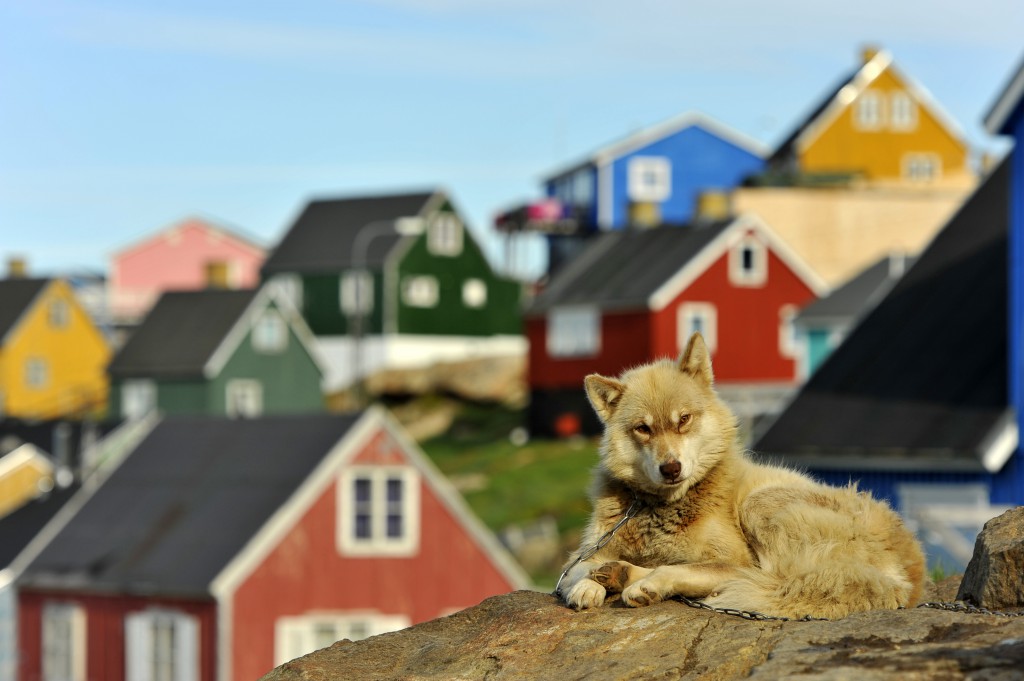Under the Midnight Sun
The ship’s horn roars and bellows, the sound booming and dancing its way down the narrow valley, echoing off ancient stone walls and filling every weather-worn crag and cranny. It lingers in the ear, reluctant to succumb to the absolute silence that permeates the fjord we’re sailing through. We’re winning in a friendly ship-on-ship tooting rivalry as another ferry passes on our port side, but I can imagine that from the peaks above, we’re nothing more than noisy specks of white on a winding ribbon of Arctic blue.
If one ever needs a reminder of how insignificant we are in the face of Mother Nature, a cruise through the Geiranger Fjord in Norway should do it. This mesmerising landscape is a significant drawcard for tourists to the country’s island-strewn west coast, and many cruise lines ply the narrow channels of the Storfjord, the intricate Great Fjord of which Geiranger is a tributary. Here on the aft deck of Hurtigruten’s MS Nordlys, passengers scramble for a better view as yachts and other ships glide past, if only to give their photographs scale against the sheer, mile-high cliffs and plummeting waterfalls on each side of the fjord.

While many cruise lines include Norway in their itineraries, none offer the connection with the west’s isolated communities and the sense of place that comes with Hurtigruten’s ships. A Norwegian icon, the line’s ferries offer a very different experience from the holiday liners: they’re working ships, essential lifelines for the fishing villages that have called this rugged coastline home since the time of the Vikings, and as such they offer travellers a unique perspective in one of the world’s most beautiful corners.
Hurtigruten actually means the ‘express route’, and refers to a journey first forged in 1893 by government mandate to connect the isolated communities of the west coast. The route first ran between the former royal capital of Trondheim and Hammerfest; today, the Norwegian Coastal Express — often referred to as the world’s most beautiful sea voyage — links the fishing town of Bergen with the Arctic city of Kirkenes, connecting 34 ports on the 6 day journey. A few years back, Hurtingruten diversified into tourism, and now hauls as many saucer-eyed tourists as it does bags of post or pallets of frozen fish. This humble little cruise line, with its 11 ships (meaning every port is visited by two vessels per day) now boasts a whopping 2 per cent of the global cruise market — not bad for a fleet of postal ships plying the world’s extremes.

For many of those tourists, the journey up the ruggedly beautiful west coast starts in the horseshoe-shaped harbour of Bergen. The gateway to the fjords of Norway, Bergen is an ancient city that has been defined by two things: fire and fish. Once one of Scandinavia’s largest cities, Bergen is a brilliant place from which to set off on a maritime journey. The heritage and influence of passing trading cultures is infused into every building, every street name, every seagull-sentinelled statue.
Thought to have been a trading post since 1020, the former royal capital flourished as it traded cod liver oil — used at the time as a heating fuel — between northern Norway and the rest of Europe. The merchants of the Germanic Hanseatic League once owned Bryggen, a quarter of the town on the edge of the harbour, prospering on this trade. The re-creations of their colourful row houses are now world heritage-listed.
The original narrow timber-clad neighbourhoods repeatedly went up in flames as the city’s second most abundant resource (after fish) turned from building material to bone dry kindling. Fires were caused by dry summers and poor living conditions, and also were set during attacks, and as protests; the city was completely or partially destroyed in 1198, 1248 and 1413. In 1476, Bryggen was burned down by a fire started by a drunken trader, while in 1686 a great fire claimed 231 city blocks. In 1702, almost 90 per cent of the city turned to ashes, and many other infernos followed. On April 20, 1944, the cargo ship Voorbode — packed to the gunwales with explosives — ignited, destroying much of Strandsiden, the merchant quarter across from Bryggen. Anything left standing was flattened during Allied bombing raids.
But the city has always been able to dust itself off (or perhaps douse itself off) thanks to the fish trade, and there is no better place to experience Bergen’s fishy fascination than at the city’s bustling fish markets. Although somewhat touristy, the traditional market, with its sizzling grills and touts yelling daily specials, is a must-visit. Customers can nibble away at everything from grilled lobster, heaped spoons of caviar and clam chowder, to thick tuna and cod steaks cooked to perfection. There are also a few unusual bites, including reindeer sausages and minke whale meat, caught as part of Norway’s controversial annual harvest. Across the way a new indoor fish market has also opened in a chic, design-savvy building, but it lacks the draw of the traditional fish mongers.
Evidence of Norway’s other economic windfall can be seen from the summit of Fløyen Mountain, reached by a popular funicular which climbs the steep gradient with ease. Far below, imposing, blunt-nosed anchor handling tugs jostle for position in the harbour, evidence of Norway’s extensive off-shore oil industry as the world’s third largest exporter. We pass more of the oil rig ships as the MS Nordlys departs Bergen bound for Kirkenes. Families wave goodbye to loved ones travelling home to the north, and tourists lean on the rail watching our departure.
The MS Nordlys was commissioned in 1994 and caters to 622 passengers, with 462 bunks and plenty of cruise ship-like lounges in which day passengers while away their passage. Much of the outdoor activity takes place on the spacious aft deck, but like a handful of others, I’m drawn to the smaller bow observation deck. Here, I watch the dying rays of a reluctant midnight sun basking across mirror-like seas. Formations of water birds race like jet fighters above the water and the orange plume of the sun sets the landscape ablaze. It’s a staggering way to finish a day at sea.
Day break of the next day — also encountered from the wind-whipped bow — is equally dramatic as the ship ploughs its way through a brief patch of rough sea towards a sunrise that cascades across the distant peaks like golden rain. To one side is the grey nothingness of the ocean, and on the other, waves smash themselves against ancient cliffs. The sun quickly climbs into the sky as we pull in for a quick stop at Ålesund, a tiny town wreathed by deep blue water and snow-tipped mountains that’s famous for its abundance of art nouveau architecture. Cargo is loaded and families embrace on the pier, but in typical Hurtigruten fashion, the stop is short and the ship’s horn soon announces our departure, into the fjords.
We couldn’t have asked for a better day to explore these deep valleys: the waters of the 15 kilometre-long Geiranger fjord and the cloudless sky above compete with deep, velvety blues, and the numerous waterfalls tumbling down the sheer cliff faces kick up misty clouds filled with shimmering rainbows. One of Norway’s most visited sites, the Geiranger fjord is UNESCO-listed and a marvel to behold from the deck of our ship, which has suddenly because toy-like in comparison to the precipices on each side.
Geiranger is the first of several fjords we encounter during the day as we leave with many other guests and set out on the Geiranger Panorama, a bus excursion that navigates the peaks surrounding the fjord before winding its way across a landscape punctuated by lakes, valleys, waterfalls and colourful fishing hamlets. From the top of the Eagle Road, a steeply winding route that climbs straight up from the town of Geiranger at the fjord’s end, we’re rewarded with a staggering vista down the waterway and across the mountain tops.
A ferry takes guests across beautiful Lake Eikesdalsvatnet before the climb to the Gudbrands Gorge and the crown of the Trollstigen Pass, where little pyramids of rocks mark the paths of travellers before us. Snow-capped peaks ring the highway, named for the mystical creatures that are said to inhabit the high mountain passes. The 11 hairpin turns of the Troll Road, a narrow path which clings to the mountain side and ducks beneath staggeringly-tall waterfalls, is a highlight for everyone. We rejoin the ship at Molde, having had a brilliant slice of Norway’s fjordland.
It’s the excursions along the way that enhance the Hurtigruten experience. Experiencing the working ship as it plies the waterways north is fascinating — meeting holidaying couples, backpackers and locals retuning home is brilliant — but excursions to Europe’s largest salt water aquarium at Atlanterhavsparken, walking tours of Trondheim, visits to the Arctic Cathedral and the Svartisen Glacier, and journeys to North Cape (the northernmost point in Europe) make the journey truly unique.
At Bodø, I wrap up tight in bright yellow survival gear complete with plastic goggles as we brave the waters of the Saltstraumen strait by high-speed RIB boat. The strait is home to the world’s most powerful tidal current, as 13 billion cubic feet of water race from the fjord and then return with eddies and swirling maelstroms. In the Lofoten Islands, I watch re-enactments of a Viking feast, with honey-laced mead and traditional songs that are thousands of years old. In Kjøllefjord, we learn how the indigenous Sámi live in the far north and dine on reindeer soup in a traditional lavvo tent, and hear stories of the summer’s midnight sun and the winter’s long night. The excursions bring context and depth to the inspiring landscape that surrounds us along the way.
As a dog lover, in the Tromsø Wilderness Centre on Kvaløya Island I have my favourite encounter as I play with teams of huskies, including excitable five month old dogs and a handful of newborn puppies. These beautiful animals are part of teams which compete in Alaska’s annual Iditarod sledding race, and guests can learn how the pack runs and dish out the doggie love to more than 100 stranger-friendly icy-blue-eyed huskies.

For many guests, arriving at North Cape signals the end of the journey. We take turns to pose for pictures beside the massive metal globe that represents the milestone, while far below, at the base of terrifically high cliffs, waves crash from a sea chilled by the ice of the Arctic, only a thousand kilometres away. While some guests will leave the ship the next day in Kirkenes, others will head south again, following the express route as the ships of Hurtigruten link the communities which call this epic landscape home.

